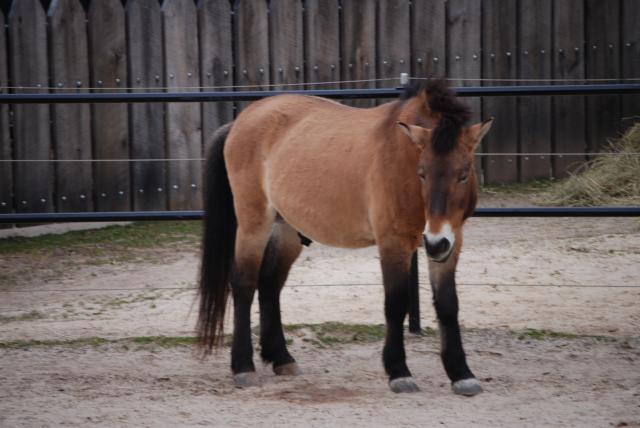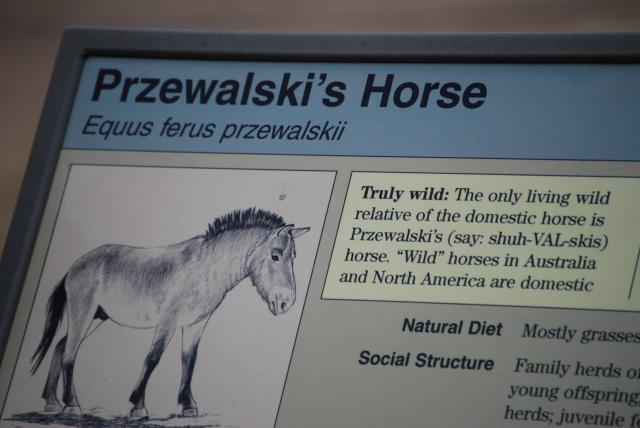|
Home Horse Breeds | First Posted: July 13, 2009 May 13, 2020 | |
Przewalski's Horse (Equus ferus przewalskii or Equus caballus przewalskii, Asian Wild Horse or Takh/GaitedNew Information on the Przewalski's Horse: Horse Evolutionary Full Genome Sequence
My husband took the above pictures of Przewalski's Horse and sign at the National Zoo. I would like to add that the Przewalski's Horse had a mate. He was not alone.
 Image ©HorseHints.org
 ©HorseHints.org Przewalski's Horse (Equus ferus przewalskii or Equus caballus przewalskii, classification is debated), pronounced in English as (væl.ski), also known as the Asian Wild Horse or Mongolian Wild Horse, or Takhi, is the closest living wild relative of the domestic Horse. Most "wild" horses today, such as the American Mustang, are actually feral animals, horses that were once domesticated but escaped and reverted to an apparently wild status. The Przewalski's Horse, on the other hand, has never been successfully domesticated and remains a truly wild animal today. There were once several types of Equid that had never been successfully domesticated, including the Tarpan, Onager, and others. However, most have become extinct, with the Przewalski's Horse the only remaining truly wild horse in the world. Poliakov, who concluded that the animal was a wild horse species, gave it the official name Equus przewalskii (Poliakov 1881). However, authorities differ about the correct classification. Some hold it is a separate species, the last remnant of the wild horse Equus ferus, others hold it is a subspecies of Equus caballus. The question will only be answered with finality if or when the common ancestor from which domestic and Przewalski's horses diverged is determined. Although the Przewalski's horse has 66 chromosomes, compared to 64 in a domestic horse, the Przewalski's horse and the domestic horse are the only equids that cross-breed and produce fertile offspring, possessing 65 chromosomes An Update:"In a Washington Post Article, June 2008, the National Zoo veterinarians successfully reversed a vasectomy on an endangered horse in an operation they described as the first of its kind. The surgery was performed on a Przewalski's horse, a species native in China and Mongolia. The horse, Minnesota, had a vasectomy in 1999 while at another zoo. He came to the National Zoo in 2006, and scientists found that the horse had high genetic value. The reverse vasectomy, performed in October, as the first to be carried out on a critically endangered species, zoo officials said. The zoo's announcement came after recent tests determined that the surgery was a success. Plans call for the zoo to mate Minnesota with a female in July." The species became extinct 40 years ago in their native Central Asian habitats. There approximately 1,500 Przewalski horses left today. Budhan Pukashenthi, a reproductive specialist teamed up with St. Louis based urologist Sherman Siber and the zoo's veterinary staff. This effort may bring this animal back from the brink of extinction. Trinomial name: Equus ferus przewalskii, (Poliakov, 1881) Przewalski's Horse (Equus ferus przewalskii or Equus caballus przewalskii, classification is debated), pronounced in English as (væl.ski), also known as the Asian Wild Horse or Mongolian Wild Horse, or Takhi, is the closest living wild relative of the domestic Horse. Most "wild" horses today, such as the American Mustang, are actually feral animals, horses that were once domesticated but escaped and reverted to an apparently wild status. The Przewalski's Horse, on the other hand, has never been successfully domesticated and remains a truly wild animal today. There were once several types of Equid that had never been successfully domesticated, including the Tarpan, Onager, and others. However, most have become extinct, with the Przewalski's Horse the only remaining truly wild horse in the world. Poliakov, who concluded that the animal was a wild horse species, gave it the official name Equus przewalskii (Poliakov 1881). However, authorities differ about the correct classification. Some hold it is a separate species, the last remnant of the wild horse Equus ferus, others hold it is a subspecies of Equus caballus. The question will only be answered with finality if or when the common ancestor from which domestic and Przewalski's horses diverged is determined. Although the Przewalski's horse has 66 chromosomes, compared to 64 in a domestic horse, the Przewalski's horse and the domestic horse are the only equids that cross-breed and produce fertile offspring, possessing 65 chromosomes. As of a census taken in 2005, the world population of these horses was about 1,500, all descended from 31 horses that were in captivity in 1945, mostly descended from approximately 15 captured around 1900. A cooperative venture between the Zoological Society of London and Mongolian Scientists has resulted in successful reintroduction of these horses from zoos into their natural habitat in Mongolia, and as of 2005 there is a free-ranging population of 248 animals in the wild.
History
The horse is named after Russian General Nikolai Przhevalsky (1839-1888). (The spelling of the horse breed as "Przewalski"derives from the Polish spelling of the name). He was an explorer and naturalist who described the horse in 1881, after having gone on an expedition to find it, based on rumors of its existence. Many of these horses were captured around 1900 by Carl Hagenbeck and placed in zoos. As noted above, about twelve to fifteen reproduced and formed today's population. The native population declined in the 20th century due to a combination of factors, with the wild population in Mongolia dying out in the 1960s. The last herd was sighted in 1967 and the last individual horse in 1969. Expeditions after this failed to locate any horses, and the species was designated "extinct in the wild" for over 30 years. After 1945 only two captive populations in zoos remained: in Munich and in Prague Zoo. The most valuable group in Askania Nova was shot down by German soldiers during occupation and the group in the USA had died. In 1977, the Foundation for the Preservation and Protection of the Przewalski Horse was founded by Jan and Inge Bouman, which started a program of exchange between captive populations in zoos throughout the world to reduce inbreeding, and later starting a breeding program of its own. In 1992, sixteen horses were released into the wild in Mongolia, followed by additional animals later on. These reintroduced horses successfully reproduced, and the status of the animal was changed from "extinct in the wild" to "endangered" in 2005. The area to which they were reintroduced became Hustai National Park in 1998.
A herd of Przewalski's Horses at Hustai National Park, Mongolia
Other Reserves for the Przewalski's Horse
Appearance and behavior
Przewalski's Horse is stockily built in comparison to domesticated horses, with shorter legs. Typical height is about 13 hands (1.32 m), length is about 2.1 m with a 90 cm tail. They weigh around 350 kg. The coat is similar to Dun coloration in domestic horses. It varies from dark brown around the mane (which stands erect) to pale brown on the flanks and yellowish-white on the belly. The legs of the Przewalski's Horse are often faintly striped. In the wild, Przewalski's Horses live in social groups consisting of a dominant male, several mares, and their offspring. Each group has a well-defined home range; within the range, the herd travels between three and six miles a day, spending time grazing, drinking, using salt licks, dozing, and taking mud baths. At night, the herd clusters and sleeps for about four hours. Ranges of different herds may overlap without conflict, as the stallions are more protective of their harem than their territory. The stallions practice a form of scent marking and will establish piles of dung at intervals along routes they normally travel to warn other males of their presence. In addition, when a female in the herd urinates, the stallion will frequently urinate in the same place, to signal her membership in his harem to other males. The stallions can frequently be seen sniffing dung piles to confirm scent markings. Fillies and colts both leave their natal groups as they reach sexual maturity, usually driven out by the dominant stallion. Fillies generally look for a new herd to join, after which they will begin to reproduce. Colts usually find one another and spend a year or two in small bachelor herds. At around age 5, a stallion will leave the bachelor herd and attempt to take over an existing herd by challenging the dominant stallion, or by "stealing" one or more mares from another stallion's harem, or by gathering unattached fillies. For More Information: Przewalski's Horse Project Short of Funds |